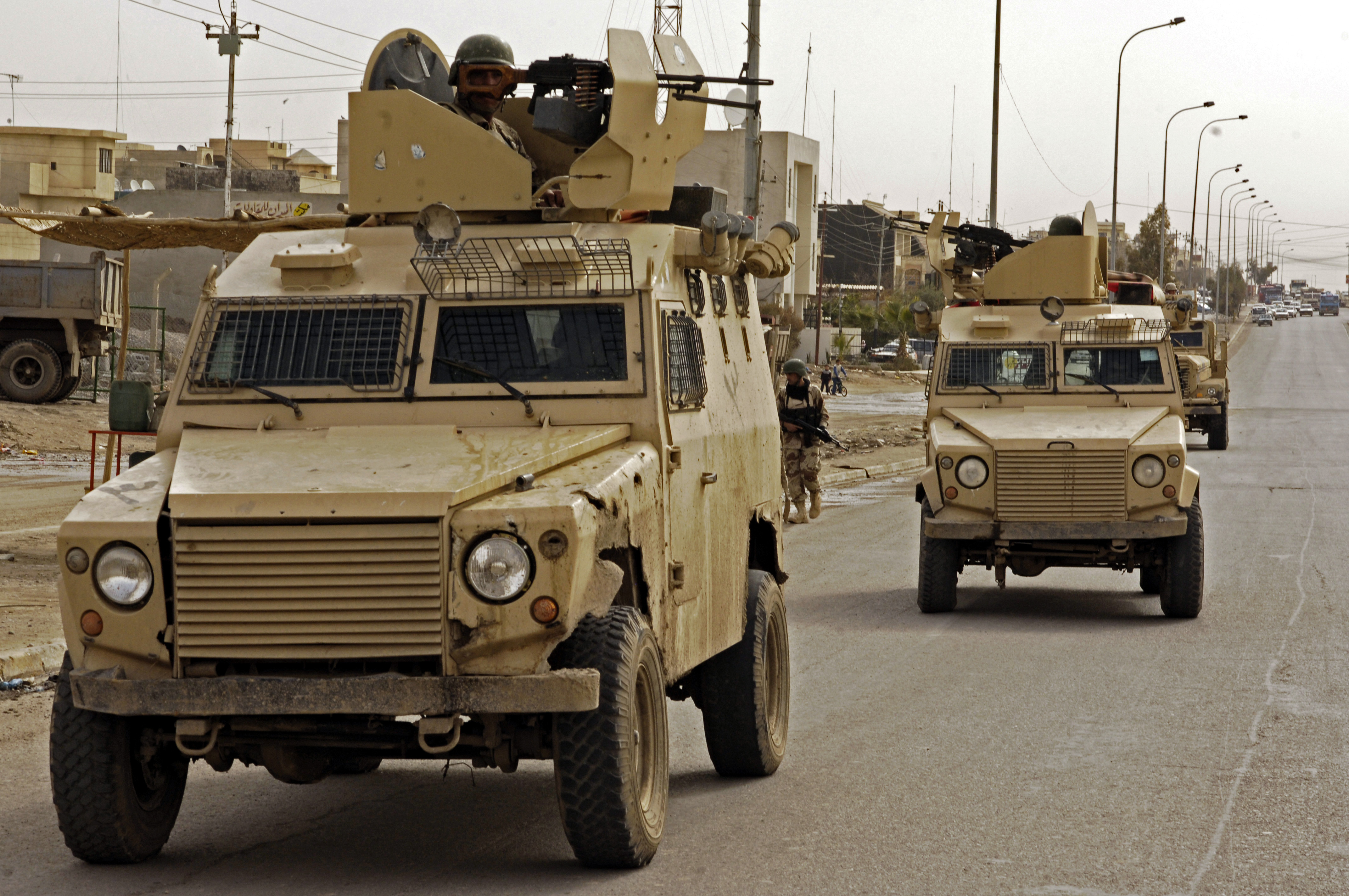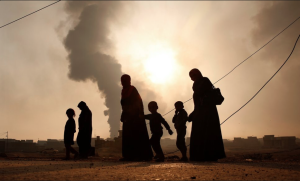In the Shadows of Mosul
 Iraqi Army in Mosul
https://goo.gl/sRYwbe
Iraqi Army in Mosul
https://goo.gl/sRYwbe
On October 17th, Iraqi forces led the advance on Mosul to recapture the city that had fallen to the self-proclaimed Islamic State in June 2014. Emboldened by their capture of Fallujah and further territory in Syria, 800 militants of the Islamic State attacked Mosul, causing between 10,000 and 30,000 soldiers and police from the Iraqi forces to shed their uniforms and flee the city. The success of the attack was a turning point as it signified the Islamic State’s rise as a major force and its ability to control large territories, such as Mosul, where ISIS leader Abu Bakr al-Baghdadi proclaimed parts of Iraq and Syria as a “caliphate”.
Mosul is Iraq’s second largest city and “one of [it]’s most diverse, comprising ethnic Sunni Arabs, Kurds, Assyrians and Turkmens, as well as a variety of other religious minorities”. However, many of these religious and ethnic minorities had to flee ISIS’s brutality, even though many Sunni Arabs, angered by sectarian policies and ‘second-class treatment’ at the hands of the previous Shia-led central government, initially welcomed the militants. Maliki emerged as President in 2006 as a product of the transitional government following the US occupation in 2003. The answer for Mosul’s rapid fall can be traced back in large part, to the 8 years of the former President’s Shia sectarianism, dictated by his ‘entirely pragmatic view of Iraqi politics”. A vision designed ‘solely to further the interests of his (Shi’ite) constituency’ – which makes up for 60- 65% of the population, whilst Sunnis comprise 37% of the Iraqi population. Maliki’s ‘sectarian logics’ consequently failed to incorporate 40% of the population in Iraqi politics leading to massive disenfranchisement of the Sunni community, leaving them to the extremists, who would ‘exploit Sunni community’s sense of dispossession in Iraq’.
Adding to the ethnic complexities within the population are the ethnic cleavages among those vying to battle and the ‘sectarian passions’ which have surfaced in its wake. Hostility has risen predominantly between the Turkish Peshmerga and the Iraqi led forces, in their united effort to clear villages (many of which are historically Kurdish) and place them under Iraqi hold. This has caused much concern, as it complicates not only the logistics of battle but also the outcome and fate of a liberated Mosul.
Currently, there are 30,000 troops involved in the operation: the bulk of which consist of Iraqi soldiers and Kurdish Peshmerga fighters. The land battle is being carried out on two fronts, with Iraqi forces attacking Mosul ‘on the southern and southeastern fronts, while the Peshmerga carry out their operation to the east’. In addition, Iraqis and Kurdish Peshmerga are being supported by ‘Shia paramilitary forces, Sunni tribesmen and US-led coalition air strikes’. Whilst leading the air-strike offensive, Washington has prevented its troops from directing ground operations in Mosul, insisting that ‘the focus of its troops in the country is to train, advise and equip local forces which are battling Islamic State and that U.S servicemen there have no combat role”.
The threats undermining the liberation process are not solely external in the form of ISIS, but also come from within the internal configuration of the operational forces. Though unified in the desire to defeat ISIS in Mosul, groups of Kurdish, Iraqi and Shia descent historically have long and brutal sectarian divisions between them, which a common enemy can only suppress for so long.
The challenge resides in whether Kurdish, Iraqi and Shia coalition forces will manage to push differences aside for the sake of attaining their shared goal, or whether their tensions will surface during combat and potentially destroy the hope for liberation. It raises the question of whether the liberation of Mosul is merely the pre-amble of a more important power struggle for each side to claim their share. As one Kurdish Peshmerga officer, pointing to flags of glorified Shia Imams on Iraqi army artillery, states “They are aiming for a sectarian conquest […] This is not a war of liberation”. Iraqi Prime Minister Abadi, has been particularly sensitive to the risks of inter-ethnic confrontations, ordering that only Iraqi forces be allowed to operate within the Sunni-Majority city, for ‘fears that the operation would provoke sectarian bloodletting’. These concerns were echoed by local Sunni representatives as well as Sunni majority states in the region where Turkey and Saudi Arabia have both warned of the dangers surrounding direct confrontation between local residents and Shia militias.

The main point of tension, as mentioned, is found within the Turkish-Iraqi collaborative mission in liberating territories, as ‘Peshmerga forces continue to ‘[clear] villages to the north-east… of the city… handing over liberated areas to Iraqi troops who alone will advance further into Mosul itself”. In spite of these successes, Iraqi forces are greatly opposed to any Turkish participation. Abadi responded to President Erdogan’s claims of “a historical responsibility in the region,” with a warning to Turkish forces who may seek to enter the city: “We are ready for them,” Mr. Abadi said. “This is not a threat… this is about Iraqi dignity.”
The uncertainty of the outcome resides in recognizing that a unified front against ISIS does not alleviate deep divisions between communities, ‘divided over a host of other issues including the fate of territories’. It can be argued therefore, that the success of the liberation and future of the Mosul and the surrounding area will ultimately depend on the ability and willingness of these sectarian forces to cooperate with one another.
On the other side, the ISIS presence in Mosul, estimated at 6,000 fighters, should not be underestimated. Having lost ‘a third of its territory in Syria and Iraq in the past year’ and now threatened with losing its last prominent foothold, many expect ISIS to present fierce resistance in combat. As the conflict unfolds, ISIS will likely rely on textbook guerrilla tactics, deployed for decades to adjust asymmetric conflicts. In order to counter balance the technological and military edge of the allied forces, ISIS militants will be operating from deep within the city’s civilian quarters: ‘hidden among an estimated … population of 600,000’. “They’re going to be seeing more suicide attacks, more blending back into the population, back into their strongholds in Anbar province,” said Nicholas A. Glavin, a terrorism and insurgency researcher at the U.S. Naval War College. A vital consideration then for the allied operational front is to ensure that ‘as [ISIS] dissolves into insurgency’ it does not succeed in ‘harnessing the support of disenfranchised Sunnis’, giving them a reason to continue the terrorist threat beyond the battle. By using citizens as human shields ISIS has rendered matters extremely delicate for their opponents, forcing them to operate with extreme precision and caution, particularly when carrying out air strikes. Abu Mahir, a local, reports “It’s quite clear Daesh has started to use civilians as human shields by requiring families to remain in buildings likely to be targeted by air strikes,” where a reported 550 families have already been taken by Islamic state militants. ISIS’s aims are clear: to change the nature of air-strike targets by using civilians as shields, ultimately inflict damage on inhabitants in order to drive survivors to seek solace and revenge in the arms of Islamic militancy. Brigadier Haider Abdul Muhsin al-Darraji conveys the difficulty of the task, stating: “Its just like a tough surgery to remove a brain tumour,”. If the coalition forces are not careful, they could breed the next generation of combat militants.
Although defeating the terrorists will be a victory in itself, it is important not to glorify the fall of ISIS without considering the challenges Iraq will face in the future. Considering the defeat of ISIS a ‘task completed’ would only grant extremists further success in the long run, relieving self-satisfied politicians once more from the issues that have long condemned the nation to civil strife: notably the brutal sectarianism that prescribes Iraqi politics. This must be considered in order to break the cycle which currently holds the system hostage, or else those who are presently alienated and dispossessed may have to live through violence and in insecurity again. Under Saddam Hussein, the Shias were marginalized; today, it is the Sunnis. It is crucial not to narrow the scope of the task at hand, as it risks obscuring what needs to be addressed in the future. When the battle is fought, the war will not be over.
As Libya and other ‘liberations’ have demonstrated, in order to prevent future calamity it is essential not to create vacuums that can be filled when the state is most vulnerable. Contrary to this principle, the Iraqi government has been flushing out key positions, including the Iraqi defence, finance and interior ministers who have all recently been dismissed from office, with no succession in line. The task ahead is whether leaders in the local and national political body ‘can learn the lessons of the past and douse the country’s simmering sectarian tensions”.
Needed most in designing a clear strategy for liberation is the genuine acknowledgement and revision of the mistakes made in the past which led to the outbreak of ISIS in the first place; namely, addressing widespread Sunni marginalization at the hands of Shia discriminatory politics. Nor should it be taken for granted that a physical defeat of ISIS as a ‘territorial power’ will eradicate deeper psychological vulnerabilities among the populous that welcomed its rise in the first place. As former Middle East analyst for the Department of National Defense, Thomas Juneau states: “IS is not the source of the problem now. IS is a symptom of completely broken politics in Iraq… even if you defeat IS militarily… you won’t have solved any problems. The problem is fundamentally the massive level of Sunni disenfranchisement in western Iraq.” Moreover, even if ISIS falls tomorrow, their success of capturing territory, challenging the international powers and temporarily ‘reviving’ the caliphate will live on through the inspiration given to both aspirant and current Islamic extremists in a ‘terrorist diaspora’ for years to come.
Essentially, the cure resides in addressing and ultimately eliminating the root traumas in Iraqi society, which allowed a group like ISIS to grow and prosper. This will require the hard work of embracing disenfranchised communities and allowing them a place and a voice within the government and the politics of their country. Only a true sense of belonging will close the space from which feelings of rejection can grow into opposition and radicalization. “Unless those [grievances] are addressed, we’re going to be seeing an ISIS 2.0 [emerge]”. It is up to the Iraqi government to take responsibility for addressing these grievances, and to right past wrongs once and for all.
